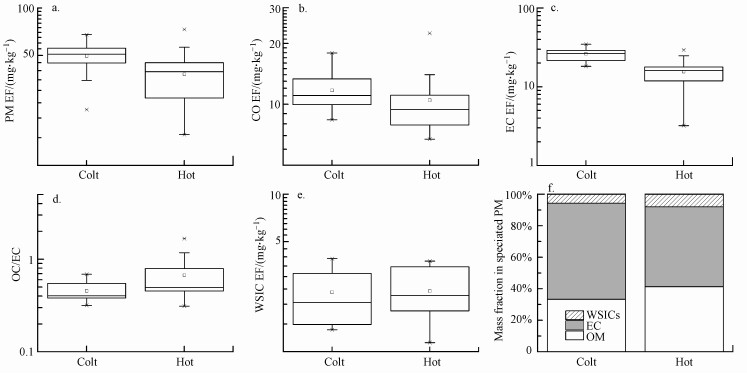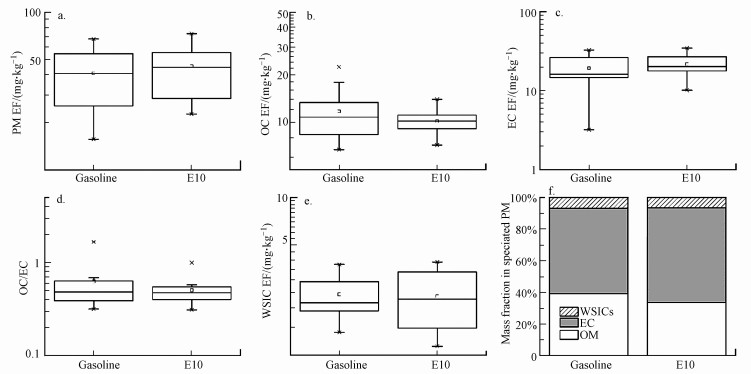2. 清华大学汽车安全与节能国家重点实验室, 北京 100084;
3. 江苏省大气环境与装备技术协同创新中心, 南京信息工程大学, 南京 210044
2. State Key Laboratory of Automotive Safety and Energy, Tsinghua University, Beijing 100084;
3. Cooperative Innovation Center of Atmospheric Environment and Equipment Technology, Nanjing University of Information Engineering, Jiangsu, Nanjing 210044
随着中国经济的蓬勃发展和城市一体化进程的加快, 我国机动车保有量增幅迅猛, 机动车排放已经成为各大城市中大气颗粒物的重要来源(Guo et al., 2012; Wu et al., 2017; Tang et al., 2018).机动车排放的颗粒物组分复杂, 分子量涵盖范围广, 还含有多种官能团(如醛、酸), 其排放的多环芳烃(PAHs)和醛类能影响人类健康, 如造成心血管疾病、影响肺部功能和造成认知障碍等(Schlesinger et al., 2006; Arden et al., 2006; Cohen et al., 2017).此外, 机动车排放中的黑碳(BC)有很强的吸光性, 能削弱大气能见度进而影响气候变化(Miguel et al., 1998; Liggio et al., 2012).
现有研究表明, 机动车排放的一次颗粒物主要由碳质气溶胶构成, 即元素碳(EC)和有机碳(OC), 直接排放的OC即可以认为是一次有机气溶胶(POA)(Sawyer et al., 2000; May et al., 2013; Gentner et al., 2017).此外, 也含有硫酸盐、硝酸盐、铵盐和其他诸如金属元素等无机组分(Qi et al., 2011).POA包含上千种有机物, 主要来自于未燃油、未燃烧的润滑油以及不完全燃烧的副产物(Schauer et al., 2002).元素碳主要来自燃料的不完全燃烧.目前对机动车研究的结果表明, 机动车颗粒物排放因子和化学组成受车辆类别影响较大, 其中机动车类别、尺寸、燃油类型、行驶工况、制造年份、发动机类型、后处理措施以及是否公路行驶是影响的主要原因(Fraser et al., 1998; Kirchstetter et al., 1999; Ban-Weiss et al., 2008; Dallmann et al., 2012; Gentner et al., 2012).在现有机动车类别中, 由于居民需求的日益增加, 轻型客车的比例增长最为迅猛(Wu et al., 2017).汽油直接喷射(GDI)发动机具有高热效能以及减少碳氢化合物和氮氧化物等优势, 正逐步在客车中占据主导地位.随着燃油法规的愈加严苛, 专家们认为到2020年, 全球使用GDI发动机的汽油车保有量将超过进气口燃油喷射汽油车(PFI)(Shuai et al., 2018).
我国于2013年发布《轻型汽车污染物排放限值及测量方法(中国第五阶段)》(又称国V标准), 并于2017年7月1日起在全国范围内实施(Wu et al., 2017).其中, 包括北京、天津、河北省、辽宁省、上海市在内的东部11省市于2016年4月1日起实施国V标准.根据中华人民共和国生态环境部公布的2018年《中国移动源环境管理年报》数据显示, 截至2018年年底, 我国机动车保有量达到3.27亿辆, 其中汽车保有量为23121.8万辆, 在机动车中占有主导地位(~73%).其中, 国V及以上标准汽车占30.9%, 高达6999.3万辆.目前对我国国V汽油车的颗粒物的排放特征、化学组成及与发达国家的对比等研究较少.因此, 需要对国V汽油车颗粒物排放情况进行详细研究.
本研究使用符合现行国V标准的GDI汽油车进行整车转鼓实验, 采集不同工况条件下的GDI汽油车排放的颗粒物样品, 对其排放因子、化学组成等方面进行了研究, 此外, 本研究探讨了油品类型、冷热启动和循环工况对GDI汽油车颗粒物排放的研究, 能够为我国机动车控制对策研究提供数据支持和理论依据.
2 研究方法(Study methods) 2.1 样品采集本研究使用通用公司的雪佛兰迈锐宝1.5 T排量的缸内直喷汽油车(GDI)进行整车转鼓实验, 该车型符合国V排放标准.该被测汽油车的结构参数和实验条件如表 1所示.GDI汽油车排放的尾气经稀释通道稀释后经过恒定容积采样器(CVS)后采样, 采样膜包括石英膜(Whatman Inc, USA, 47 mm)和Teflon膜(Whatman Inc, USA, 47 mm), 采样时间为30 min, 采样流量为10.0 L · min-1.
| 表 1 GDI汽油车结构参数及实验条件 Table 1 Specifications and experimental conditions for GDI gasoline vehicle |
本研究探索了油品类型、冷热启动和循环工况几种不同的条件对颗粒物排放因子的影响.所测油品分别为商用汽油和添加乙醇含量为10%的E10汽油;所测启动方式分别为冷启动和热启动.冷启动工况是发动机未经运转12 h以上后未经预热情况下直接启动的工况.热启动指的是汽车进行测试之前, 经过预热, 并在恒定速度下运行半小时之后再开始测试的情况.本研究中也测试了两种不同的循环对颗粒物排放因子的影响, 两种循环分别为全球测试循环(WLTC)和中国工况循环(CLTC).WLTC循环是用来模拟全球机动车运行的实际工况, 其基于欧洲、印度、日本、韩国和美国的实际运行工况, 基于一定的权重得到的循环工况, 包含4个速度梯度, 低速、中速、高速和超高速, 涵盖了城市、郊区和高速公路的运行情况(Tutuianu et al., 2015).目前, 国VI标准汽油车测试循环采用WLTC循环代替国V汽油车测试标准中使用的新标欧洲测试循环(NEDC).自2017年开始, 欧洲标准也放弃使用NEDC循环, 转而使用WLTC循环.现有研究结果表明, 从油耗水平和污染物排放等方面来看, NEDC循环对中国实际行驶工况来说过于温和, 不能反映实际中国工况的情况(Ma et al., 2019).对WLTC循环排放特征的探究是有必要的.CLTC是基于中国轻型客车的实际运行情况设计的循环方式, 更多的考虑了中国的实际道路情况和驾驶特征, 可以分为低速、中速和高速3个阶段, 有更多的怠速和缓加速情况.两种工况的速度设置见图 1.
 |
| 图 1 WLTC和CLTC循环的速度情况 Fig. 1 The speed of WLTC and CLTC |
为了保证实验的可靠性和可重复性, 每个工况进行3次以上重复性实验.采样前, 石英纤维滤膜在550 ℃条件下经马弗炉高温灼烧5.5 h, 以去除膜上的有机物.采样结束后, Teflon滤膜放于洁净的膜盒中, 并用垫环压好.石英纤维滤膜放于经马弗炉高温灼烧的铝箔包裹的膜盒中.整理完毕的膜置于密封袋中在冰箱-20 ℃条件下冷冻保存后待用.
2.2 样品分析 2.2.1 颗粒物质量分析采样前后将Teflon滤膜置于超净室中平衡24 h以上, 温度为(20±1) ℃, 相对湿度为40%±5%, 用十万分之一天平(AX105DR, 瑞士Mettler Toledo)称量采样前后的Teflon膜质量, 根据采样体积可以获得颗粒物质量浓度.
2.2.2 颗粒物化学组成分析使用美国Sunset EC/OC分析仪采用热光透射法(NIOSH5040方法)分析石英膜上采集的有机碳(OC)和元素碳(EC).仪器检出限为0.2 μg · m-3, 精密度为±5%.
颗粒物的无机离子采用离子色谱分析.将称量过的Teflon膜使用20 mL超纯水(Milli-Q Gradient纯水机, 18.2 MΩ · cm)常温(小于30 ℃)超声提取30 min, 提取液经0.45 μm滤膜过滤后收集到离心管中.其中阴阳离子分别使用Dionex ICS-2500和ICS-2000型离子色谱仪分析.分析的阳离子包括Na+、NH4+、K+、Mg2+、Ca2+, 阴离子包括Cl-、NO3-和SO42-.
2.2.3 排放因子计算本研究中报道的排放因子均为基于油的排放因子, 即使用碳平衡方法利用测到的污染物浓度计算而得到.计算公式如下:

|
式中, Δmi为CVS中物种i扣除背景浓度之后的质量浓度, xc为油品分析中得到的C的质量分数, ΔCO2为CVS中测到的背景校正之后的二氧化碳的浓度(以碳量计).本研究所有排放因子的计算均基于上式(Zhao et al., 2015).
3 结果与讨论(Results and discussion) 3.1 GDI汽油车颗粒物排放情况所测国V汽油车的平均PM、POA、EC、WSIC排放因子分别为(43.4±16.2)、(11.0±3.5)、(20.5±8.1)以及(2.4±0.9) mg · kg-1.国V排放标准中对PM的排放因子进行了限制.与之相比(4.5 mg · km-1), 本研究中PM排放((0.24±0.09) mg · km-1)符合国V标准.在所有颗粒物组分中, 元素碳占颗粒物排放的重要组成部分(~47%), 其次为有机物排放(~41%), 水溶性离子组分在颗粒物排放中占比较低(~5%).表 2将本文所得的研究结果与国内外类似标准(国V参照欧V的标准)下的GDI汽油车的颗粒物排放进行比较, 可以看出, 所测国V车辆的PM2.5和POA的排放因子均低于之前的研究, 而元素碳的排放因子明显高于欧V.这些可能与所测车的油品、冷热启动、运行工况、制造年份及发动机设计等息息相关(Gentner et al., 2017).本研究将从油品、冷热启动和运行工况3个方面探讨这些因素对颗粒物排放特征的影响.
| 表 2 本文颗粒物排放因子(PM2.5, POA, EC)与其他文献的比较 Table 2 EFs of particulate matter in this study and those of previous studies |
图 2对比了冷热启动下颗粒物排放因子的情况.从图中可以看出, 冷启动条件下, PM、OC、EC的排放因子均高于热启动工况.这也与之前的研究结果相一致(Chen et al., 2012; Xing et al., 2019).对OC/EC来说, 热启动工况下平均OC/EC要高于冷启动, 表明在热启动中OC在颗粒物中的占比较高.冷热启动条件下WSIC的排放因子相差不大, 而且水溶性离子中各离子组成和比例也大致不变, 这表明冷热启动对水溶性无机物的排放影响较小, 并不是影响WSIC排放的重要原因.对颗粒物中化学组分的研究表明, 热启动情况下有机物占比更高, 可能是由于热启动时, 机内和缸内的温度较高, 壁面油蒸发快, 油气混合更为均匀, 不利于EC的形成.另一方面, 车辆热启动时, 转速高, 缸内燃烧温度的提高可促进对颗粒物的氧化作用, 从而导致颗粒物种OC质量的增加(Hu et al., 2017).
 |
| 图 2 启动方式对颗粒物排放因子的影响 (a.颗粒物, b, 有机碳, c.元素碳, d. OC/EC, e.水溶性无机离子, f.颗粒物种不同组分的比例情况) Fig. 2 Influence of startup mode on particulate matter emission factors (a.particulate matter, b.organic carbon, c.elemental carbon, d.OC/EC, e.WSIC, f.the proportion of different components of particulate matter) |
图 3展示了不同油品对颗粒物排放因子的影响.从图中可以看出, 纯汽油和E10汽油的平均PM排放因子相当, 进一步结合统计检验结果也发现二者没有显著差异, 这表明E10汽油对颗粒物排放因子的作用较小, 这与之前的研究结果相似.Costagliola等对比了不同乙醇含量(0、5%、10%、20%)汽油的PM排放因子, 研究结果表明乙醇含量对颗粒物排放因子的影响不大(Costagliola et al., 2016).Wang等的研究结果也得到了相似的结论, 即E10汽油对颗粒物排放的影响不大(Wang et al., 2016).从图 3b、3c来看, OC、EC排放因子也呈现出了相同的特征, 即E10和汽油作为燃料产生的OC、EC排放因子相差不大, 统计检验结果也发现二者没有显著差异.对汽油和E10油来说, 平均OC/EC排放因子均小于1, 表明了EC在颗粒物排放中的重要作用.从本研究的结果可以看到油品对水溶性离子排放因子的影响也不大, E10和汽油的平均水溶性离子的排放因子相当; 分析水溶性离子的具体组成, 两种油的各离子排放也比较相似.总的来说, 使用汽油和E10作为燃料时, 均呈现出EC占比高于OC, WSIC占比最小的情况, 使用汽油和添加10%乙醇的E10油对颗粒物排放因子的影响不大.
 |
| 图 3 油品对颗粒物排放因子的影响 (a.颗粒物, b.有机碳, c.元素碳, d. OC/EC, e.水溶性无机离子, f.颗粒物种不同组分的比例情况) Fig. 3 Influence of oil on particulate matter emission factors (a.particulate matter, b.organic carbon, c.elemental carbon, d.OC/EC, e.WSIC, f. the proportion of different components of particulate matter) |
图 4展示了不同循环工况对颗粒物排放因子的影响.本研究中共研究了两种循环工况, 一种是WLTC循环, 另一种是符合中国实际道路情况及行驶工况的CLTC循环.对两种工况的颗粒物排放因子的对比结果表明, CLTC循环的PM、OC、WSIC的排放因子均高于WLTC循环.然而, WLTC循环的平均EC排放因子略高于CLTC循环.对PM的化学组成分析表明, CLTC循环中的有机物占比要高于WLTC循环, 水溶性有机物仍然在排放中占比最低, 而从具体的离子来看, CLTC中铵离子的占比要明显高于WLTC而氯离子要明显低.为了研究该原因, 本研究对图 1的循环工况进行分析.分析结果表明, CLTC和WLTC循环的重要区别在于, CLTC循环拥有更多的怠速和缓加速的情况.因此, 本研究对不同的加速度工况对颗粒物排放的影响进行了研究.加速工况包括怠速、加速度为0.3/1.0和1.7 m · s-2的工况, 分别简写为Idle、ACR0.3、ACR1.0和ACR1.7, 加速工况设置见图 5.加速工况设置的基本原则为, 保证不同的加速循环行驶时间一致, 加速后最大速度保持一致, 行驶路程一致, 从而保证每个加速循环中的平均速度保持一致.图 6展示了怠速和不同加速条件下PM、OC、EC和WSIC的排放因子.从图中可以看出, 不同的加速条件能够影响颗粒物PM、OC、EC及WSIC的排放因子.PM的排放因子在怠速条件下最高, 其次加速度为0.3 m · s-2的情况.加速度为1.7 m · s-2时的PM排放与怠速相当.随着加速度的增大, OC和WSIC的排放因子降低.EC排放因子呈现相反的趋势, 随着加速度的增大而降低.图 6b展示了不同加速工况下, OC、EC、WSIC的占比情况.从图中可以看出, 随着加速度的增大, WSIC和有机物占比降低, EC占比不断增加.分析水溶性离子的具体组成可以发现, 各加速度下各离子占比变化不大, 但怠速和不同加速情况相比铵离子排放占比明显较高, 氯离子排放占比明显较低.结合CLTC和WLTC的颗粒物排放因子来看, 可以看出我国汽油车颗粒物的排放与加速工况相关.考虑到我国人口密度和车流量大, 尤其是在大城市, 交通拥堵现象发生频繁.频繁的缓加速情况会产生更多的有机物排放, 这些有机物可能是半挥发性和中等挥发性物种, 在气态和颗粒态中进行分配(Zhao et al., 2014;Zhao et al., 2016; Ma et al., 2017; Zhao et al., 2018; Lu et al., 2018; Drozd et al., 2018).气态的中等挥发性物种的排放可能会生成更多的二次有机气溶胶, 从而加剧城市雾霾现象.该结果证明循环工况可以影响颗粒物排放情况, 使用符合中国实际运行状况的循环可能对颗粒物排放控制更具有现实意义.同时, 该结果表明影响循环排放的重要因素是加速度情况.
 |
| 图 4 循环工况对颗粒物排放因子的影响 (a.颗粒物; b.有机碳; c.元素碳; d. OC/EC; e.水溶性无机离子; f.颗粒物种不同组分的比例情况) Fig. 4 Influence of cycling conditions on particulate matter emission factors (a.particulate matter, b.organic carbon, c.elemental carbon, d.OC/EC, e.WSIC, f. the proportion of different components of particulate matter) |
 |
| 图 5 加速工况设置 (虚线ACR0.3代表加速度为0.3 m · s-2的工况, 实线ACR1.0代表加速度为1.0 m · s-2, 点划线ACR1.7代表加速度为1.7 m · s-2的情况) Fig. 5 Working conditions of acceleration cycle, in which black dash line ACR0.3 represents the acceleration rate of 0.3 m · s-2, full line ACR1.0 is 1.0 m · s-2 acceleration rate, and dash dot line ACR1.7 lies for the acceleration rate of 1.7 m · s-2 |
 |
| 图 6 加速工况对颗粒物排放的影响 (a.排放因子; b.化学组成变化) Fig. 6 Influence of acceleration conditions on particulate matter emission factors (a.emission factors, b. chemical composition) |
1) 本研究中使用的GDI汽油车的平均PM排放因子是(43.4±16.2) mg · kg-1, 在美国Pre-LEV(1994年之前的车型)和LEV-1(1994—2003年制造的汽油车)的排放因子之间.OC的平均排放因子为(11.0±3.5) mg · kg-1, 其OC排放因子与美国LEV-1阶段的OC排放因子相近.所测GDI汽油车EC的平均排放因子为(20.5±8.1) mg · kg-1, 与美国不同阶段的车型的平均EC排放因子相当.本研究中国V汽油车排放的颗粒物化学组分分布与美国新型汽油车相接近, 即EC占比最高, 其次是OC, 占比最小的是WSIC.从我国汽油车的颗粒物排放因子高于LEV-2阶段来看, 我国仍然需要进一步控制汽油车颗粒物的排放.
2) 本研究探讨了不同启动状态、油品和循环对颗粒物排放的影响, 结果表明E10汽油与纯汽油的颗粒物排放因子相差不大, 冷启动和循环方式能够影响汽油车颗粒物排放.其中, 冷启动的颗粒物排放因子高于热启动, 但是热启动工况下有机碳的占比更高, 可能是由于高温促进了有机物的氧化.CLTC循环的颗粒物排放因子高于WLTC循环, 且有机物含量占比较高, 这表明, 在中国汽油车实际行驶工况下, 可能会有更高的二次有机气溶胶生成潜势.在未来的研究过程中, 需要考虑不同循环工况对测试结果的影响, 这对研究中国汽油车的节能减排、制定符合我国国情的汽车排放标准具有更加重要的意义.
3) 本研究探讨了不同的加速工况对颗粒物排放的影响, 结果表明怠速和缓加速情况的PM、OC和WSIC排放更多, 这可能是造成CLTC循环中颗粒物排放更多的重要原因.我国人口众多, 车流量大, 堵车现象严重, 尤其是在北京、上海、广州等大城市, 高峰时段频繁的怠速和缓加速会造成更多的PM、OC和WSIC排放, 这些物种排放会给城市大气环境带来负面的贡献, 有造成城市环境恶化的潜在可能性.本研究可以为机动车控制对策提供数据支持和理论依据.
Arden P, Dockery D W. 2006. Health effects of fine particulate air pollution:lines that connect[J]. Journal of the Air & Waste Management Association, 56(6): 707-708. |
Ban-Weiss G A, Mclaughlin J P, Harley R A, et al. 2008. Carbonyl and nitrogen dioxide emissions from gasoline- and diesel-powered motor vehicles[J]. Environmental Science & Technology, 42(11): 3944. |
Chen L, Stone R, Richardson D. 2012. A study of mixture preparation and PM emissions using a direct injection engine fuelled with stoichiometric gasoline/ethanol blends[J]. Fuel, 96: 120-130. DOI:10.1016/j.fuel.2011.12.070 |
陈伟程, 吉喆, 肖寒, 等. 2017. 全国机动车保有量分析——《中国机动车环境管理年报(2017)》第Ⅰ部分[J]. 环境保护, 12: 33-34. |
Cohen A J, Brauer M, Burnett R, et al. 2017. Estimates and 25-year trends of the global burden of disease attributable to ambient air pollution:an analysis of data from the Global Burden of Diseases Study 2015[J]. Lancet, 389(10082): 1907-1918. DOI:10.1016/S0140-6736(17)30505-6 |
Costagliola M A, Prati M V, Florio S, et al. 2016. Performances and emissions of a 4-stroke motorcycle fuelled with ethanol/gasoline blends[J]. Fuel, 183: 470-477. DOI:10.1016/j.fuel.2016.06.105 |
Dallmann T R, Demartini S J, Kirchstetter T W, et al. 2012. On-road measurement of gas and particle phase pollutant emission factors for individual heavy-duty diesel trucks[J]. Environmental Science & Technology, 46(15): 8511-8518. |
Drozd G T, Zhao Y, Saliba G, et al. 2018. Detailed speciation of intermediate volatility and semivolatile organic compound emissions from gasoline vehicles:effects of cold starts and implications for secondary organic aerosol formation[J]. Environmental Science & Technology, 53(3): 1706-1714. |
Du Z, Hu M, Peng J, et al. 2018. Comparison of primary aerosol emission and secondary aerosol formation from gasoline direct injection and port fuel injection vehicles[J]. Atmospheric Chemistry and Physics, 18(12): 9011-9023. DOI:10.5194/acp-18-9011-2018 |
Fraser M P, Cass G R, Simoneit B R T, et al. 1998. Gas-phase and particle-phase organic compounds emitted from motor vehicle traffic in a los angeles roadway tunnel[J]. Environmental Science & Technology, 32(14): 2051-2060. |
Gentner D R, Isaacman G, Worton D R, et al. 2012. Elucidating secondary organic aerosol from diesel and gasoline vehicles through detailed characterization of organic carbon emissions[J]. Proceedings of the National Academy of Sciences of the United States of America, 109(45): 18318-18323. DOI:10.1073/pnas.1212272109 |
Gentner D R, Jathar S H, Gordon T D, et al. 2017. Review of urban secondary organic aerosol formation from gasoline and diesel motor vehicle emissions[J]. Environmental Science & Technology, 51(3): 1074-1093. |
Guo S, Hu M, Guo Q F, et al. 2012. Primary sources and secondary formation of organic aerosols in Beijing, China[J]. Environmental Science & Technology, 46(18): 9846-9853. |
Hu Z, Bo S, Hu L, et al. 2017. Effects of start conditions on the composition of particle emissions from a gasoline direct injection vehicle[J]. Journal of Tongji University, 45(2): 261-266. |
Kirchstetter T W, And B C S, Harley R A, et al. 1999. Impact of california reformulated gasoline on motor vehicle emissions. 2. Volatile organic compound speciation and reactivity[J]. Environmental Science & Technology, 33(2): 329-336. |
Liggio J, Gordon M, Smallwood G, et al. 2012. Are emissions of black carbon from gasoline vehicles underestimated? Insights from near and on-road measurements[J]. Environmental Science & Technology, 46(9): 4819-4828. |
Lu Q, Zhao Y, Robinson A L, et al. 2018. Comprehensive organic emission profiles for gasoline, diesel, and gas-turbine engines including intermediate and semi-volatile organic compound emissions[J]. Atmospheric Chemistry and Physics, 18(23): 17637-17654. DOI:10.5194/acp-18-17637-2018 |
May A A, Presto A A, Hennigan C J, et al. 2013. Gas-particle partitioning of primary organic aerosol emissions:(1) Gasoline vehicle exhaust[J]. Atmospheric Environment, 77: 128-139. DOI:10.1016/j.atmosenv.2013.04.060 |
Ma R, He X, Zheng, B, et al. 2019. Real-world driving cycles and energy consumption informed by large-sized vehicle trajectory data[J]. Journal of Cleaner Production, 223: 564-574. DOI:10.1016/j.jclepro.2019.03.002 |
Ma P K, Zhao Y, Robinson A L, et al. 2017. Evaluating the impact of new observational constraints on P-S/IVOC emissions, multi-generation oxidation, and chamber wall losses on SOA modeling for Los Angeles, CA[J]. Atmospheric Chemistry and Physics, 17(15): 9237-9259. DOI:10.5194/acp-17-9237-2017 |
Miguel, Kirchstetter T W, Harley. 1998. On-road emissions of particulate polycyclic aromatic hydrocarbons and black carbon from gasoline and diesel vehicles[J]. Environmental Science & Technology, 32(4): 450-455. |
Platt S, Haddad I E, Zardini A, et al. 2013. Secondary organic aerosol formation from gasoline vehicle emissions in a new mobile environmental reaction chamber[J]. Atmospheric Chemistry and Physics, 13(18): 9141-9158. DOI:10.5194/acp-13-9141-2013 |
Qi Z, Jimenez J L, Canagaratna M R, et al. 2011. Understanding atmospheric organic aerosols via factor analysis of aerosol mass spectrometry:a review[J]. Analytical & Bioanalytical Chemistry, 401(10): 3045-3067. |
Sawyer R F, Harley R A, Cadle S H, et al. 2000. Mobile sources critical review:1998 NARSTO assessment[J]. Atmospheric Environment, 34(12): 2161-2181. |
Schauer J J, Kleeman M J, Cass G R, et al. 2002. Measurement of emissions from air pollution sources. 5. C1-C32 organic compounds from gasoline-powered motor vehicles[J]. Environmental Science & Technology, 36(6): 1169-1180. |
Schlesinger R B, Kunzli N, Hidy G M, et al. 2006. The health relevance of ambient particulate matter characteristics:coherence of toxicological and epidemiological inferences[J]. Inhalation Toxicology, 18(2): 95-125. DOI:10.1080/08958370500306016 |
Shuai S, Xiao M, Li Y, et al. 2018. Recent progress in automotive gasoline direct injection engine technology[J]. Automotive Innovation, 1(2): 95-113. DOI:10.1007/s42154-018-0020-1 |
Tang R, Wu Z, Li X, et al. 2018. Primary and secondary organic aerosols in summer 2016 in Beijing[J]. Atmospheric Chemistry and Physics, 18(6): 4055-4068. DOI:10.5194/acp-18-4055-2018 |
Tutuianu M, Bonnel P, Ciuffo B, et al. 2015. Development of the World-wide harmonized Light duty Test Cycle (WLTC) and a possible pathway for its introduction in the European legislation[J]. Transportation Research Part D:Transport and Environment, 40: 61-75. DOI:10.1016/j.trd.2015.07.011 |
Wang Y, Zheng R, Qin Y, et al. 2016. The impact of fuel compositions on the particulate emissions of direct injection gasoline engine[J]. Fuel, 166: 543-552. DOI:10.1016/j.fuel.2015.11.019 |
Wu Y, Zhang S, Hao J, et al. 2017. On-road vehicle emissions and their control in China:A review and outlook[J]. Science of The Total Environment, 574: 332-349. DOI:10.1016/j.scitotenv.2016.09.040 |
Xing J, Shao L, Zhang W, et al. 2019. Morphology and composition of particles emitted from a port fuel injection gasoline vehicle under real-world driving test cycles[J]. Journal of Environmental Sciences, 76: 339-348. DOI:10.1016/j.jes.2018.05.026 |
Zhao Y, Hennigan C J, May A A, et al. 2014. Intermediate-volatility organic compounds:A large source of secondary organic aerosol[J]. Environmental Science & Technology, 48(23): 13743-13750. |
Zhao Y, Lambe A T, Saleh R, et al. 2018. Secondary organic aerosol production from gasoline vehicle exhaust:Effects of engine technology, cold start, and emission certification standard[J]. Environmental Science & Technology, 52: 1253-1261. |
Zhao Y, Nguyen N T, Presto A A, et al. 2015. Intermediate volatility organic compound emissions from on-road diesel vehicles:Chemical composition, emission factors, and estimated secondary organic aerosol production[J]. Environmental Science & Technology, 49(19): 11516-11526. |
Zhao Y, Nguyen N T, Presto A A, et al. 2016. Intermediate volatility organic compound emissions from on-road gasoline vehicles and small off-road gasoline engines[J]. Environmental Science & Technology, 50(8): 4554-4563. |
 2020, Vol. 40
2020, Vol. 40


